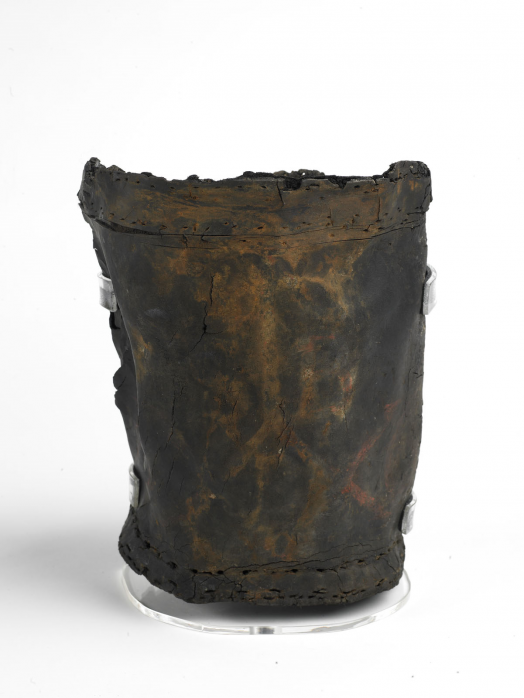
How was it found?
The bucket was found in a burned out cellar at the end of Pudding Lane along with the remains of wooden supports for barrels. The cellar and its contents were preserved under collapsed buildings and debris used to build up the ground after the Great Fire of London. The bucket may have been used to fight the Great Fire and was probably dropped in the chaos. The leather bears the initials SBB and traces of the first three figures of the date painted on it – 166 – but the final digit is unclear.
London in 1666
There were stone and brick buildings in London before the Great Fire but the majority of buildings were timber-framed or timber with stone or brick elements. These buildings were tightly packed together and the upper floors often projected out above the lower floors. This meant that flames could easily spread from building to building. There were also warehouses in the city which stored highly combustible goods, such as oil and tallow. The summer of 1666 had been very dry, leading to a drought, and the wooden houses had dried out, making them extremely combustible.
Firefighting
At that time there were no organised fire brigades. Instead, people fought fires within their own parishes using equipment stored in the local church. Firefighting involved using buckets, axes and water squirts. Fire hooks were used to pull down buildings in an attempt to stop the fire spreading to other buildings. Buckets, made from leather with a rope handle, only held a small amount of water and were passed along a line of people towards the fire. Handheld water squirts were used to douse the flames and larger-scale pumping equipment was occasionally available.
The Great Fire of London
The Great Fire of London occurred over five days in September 1666 and destroyed many buildings in the city including the Royal Exchange, the Guildhall and the medieval St Paul’s Cathedral, 13,200 houses and 87 parish churches. The official death toll was six, the first of whom was the maid at the house where the fire started.
The fire destroyed 373 acres within the city and left about 100,000 people homeless. Tents and shacks were put up to house those who had lost their homes. Conditions in these temporary living quarters were poor and many people may have died in the cold winter of 1666/7.
After the Great Fire
The fire was very costly and many people were financially ruined. Over the next 30 years London was rebuilt using stone and brick, though houses still had a lot of wood in their construction. Perhaps the most striking building was the new St Paul’s Cathedral designed by Sir Christopher Wren.
A common misperception is that the Great Fire stopped the Great Plague. The Great Plague of 1665 was largely over by September 1666 - most people who had fled London had moved back by Christmas 1665. Most of the places in London that were worst affected by the plague, for example, the slum areas outside the city walls were not burned in the Great Fire. Also scientists now think that human fleas and lice rather than rats were most likely to have spread plague. Furthermore, cases of plague continued in London until 1679.
More information
Short history
A digital Pocket History of the Great Fire of London.
http://www.museumoflondon.org.uk/explore-online/pocket-histories/what-happened-great-fire-london
Introduction to the Fire
Information on the Great Fire of London from the BBC.
http://www.bbc.co.uk/history/british/civil_war_revolution/great_fire_01.shtml
National Archives
Original sources about the fire with teaching ideas and resources from the National Archives.
http://www.nationalarchives.gov.uk/education/resources/fire-of-london/
Fire pump
Information on Keeling’s 1678 fire pump (Museum of London).
http://shar.es/LOS0S
By Permission of Heaven
Adrian Tinniswood, By Permission of Heaven: The Story of the Great Fire of London,
Pimlico Books, 2004.
http://www.adriantinniswood.co.uk/books/by_permission_of_heaven.html
More information
-
Short history
A digital Pocket History of the Great Fire of London.
Source: museumoflondon.org.uk
-
Introduction to the Fire
Information on the Great Fire of London from the BBC.
Source: bbc.co.uk
-
National Archives
Original sources about the fire with teaching ideas and resources from the National Archives.
Source: nationalarchives.gov.uk
-
Fire pump
Information on Keeling’s 1678 fire pump (Museum of London).
Source: museumoflondon.org.uk
-
By Permission of Heaven
Adrian Tinniswood, By Permission of Heaven: The Story of the Great Fire of London, Pimlico Books, 2004.
Source: adriantinniswood.co.uk


